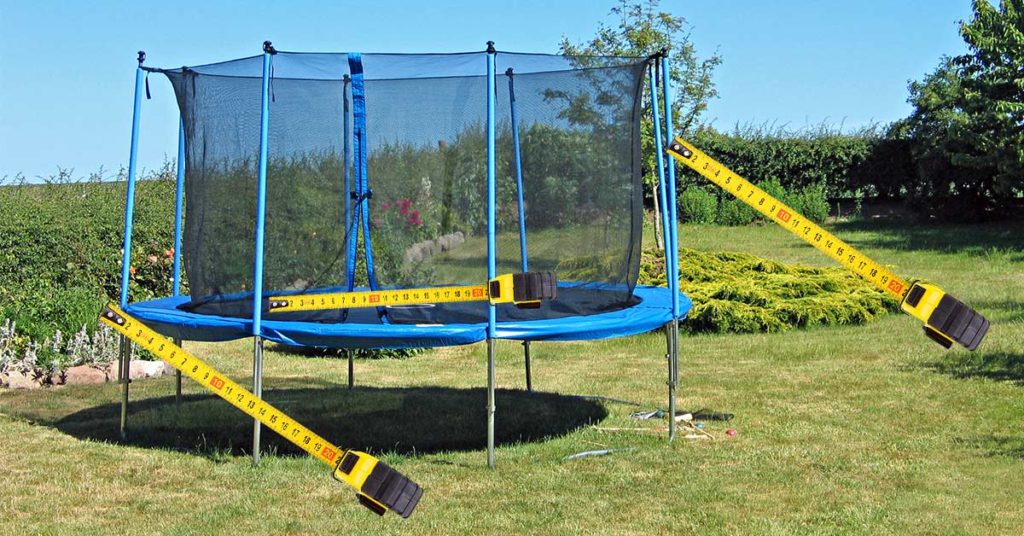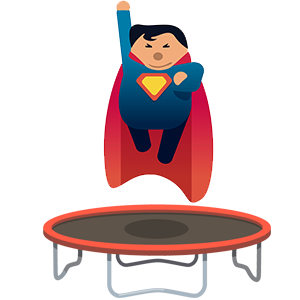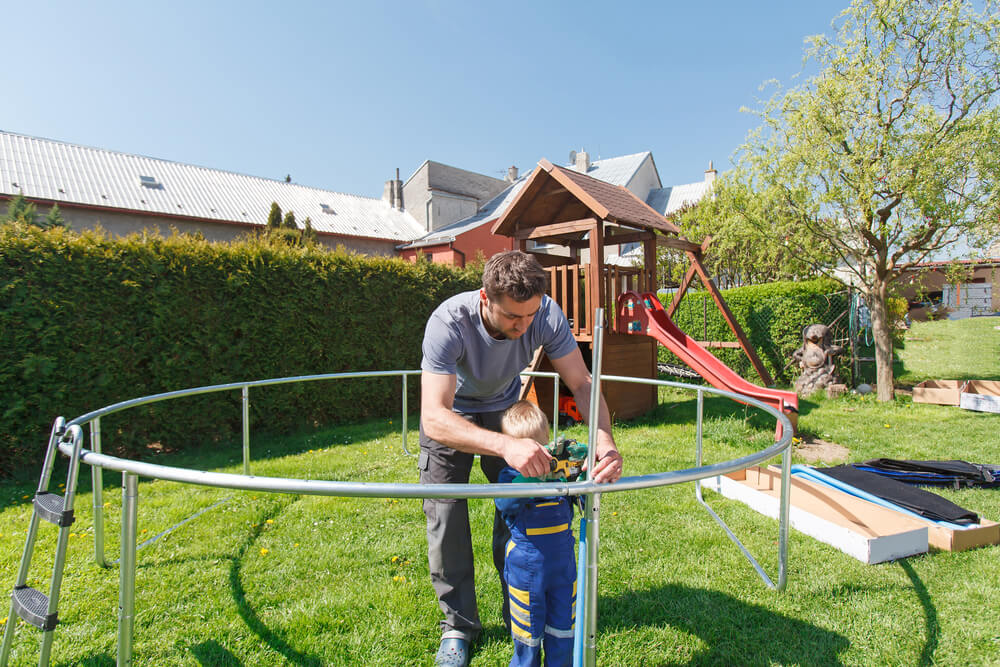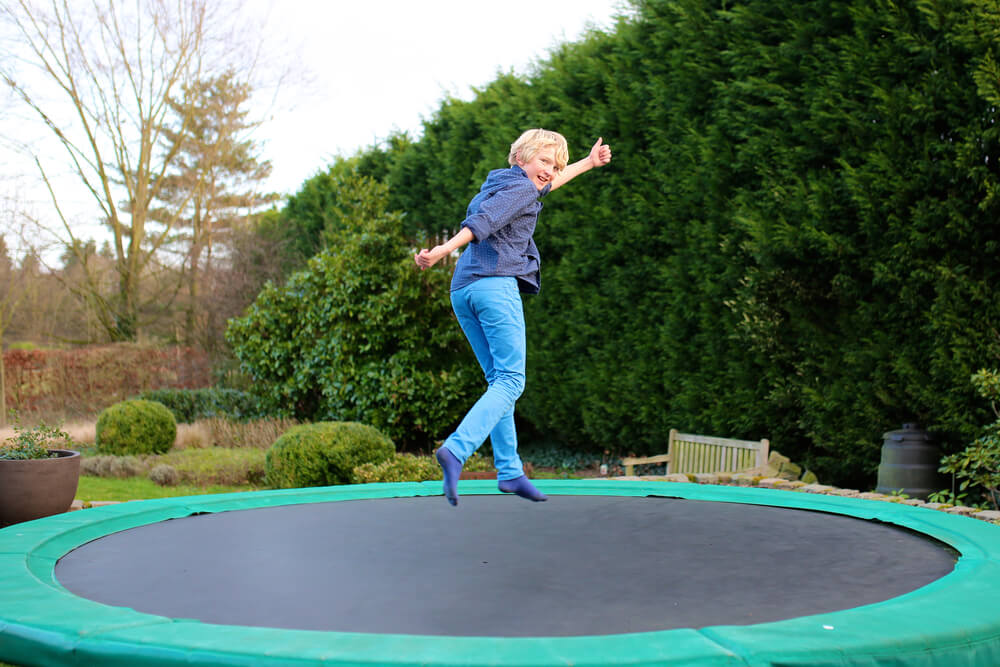The size of a trampoline is measured from one edge of its metal frame to the opposite edge. Avoid measuring the trampoline from the edge of the jumping mat, where it attaches to springs.
Also, the right way to know the size of a round trampoline is by measuring its diameter. For rectangular trampolines, measure the length and width.
If you use a tape measure, remember to convert the reading from inches to feet. Simply divide the reading’s value by 12 to find out the correct size of the trampoline.
When you know how to measure a trampoline correctly, you’ll also discover how to get a couple of other things right. For example, you’ll learn how much space to allocate the trampoline.
You’ll also know whether it will offer enough rebound space for a child, several children, or the entire family.
Getting the right trampoline replacement parts starts with knowing the size of your trampoline, too.
So, here’s a more detailed guide to buying the best size trampoline for your loved ones.
How do I know the size of my trampoline?
You’ll want to grab a measuring tape for this. You can do it alone or get someone to help.
How to measure the size of a round trampoline:
- Take your measuring tape and hook its head to one point on the trampoline’s round metal frame.
- Don’t hook it on the edge of the jumping mat, where the springs stretch back from.
- Have your helper hold the tape measure’s head down on the frame. If you are free to, walk straight across the jumping mat with the tape measure.
- If not free to step on it, roll the tape back over the trampoline as you go round its side.
- Stop at the direct opposite point of the hooked end.
- Lay the tape down flat on top of the opposite edge.
- Ensure the tape is straight in the middle of the trampoline.
- Get the reading on your end of the tape measure.
- Divide the reading value by 12 to convert it from inches to feet.
Here’s one image to summarize how all eight steps should look like:
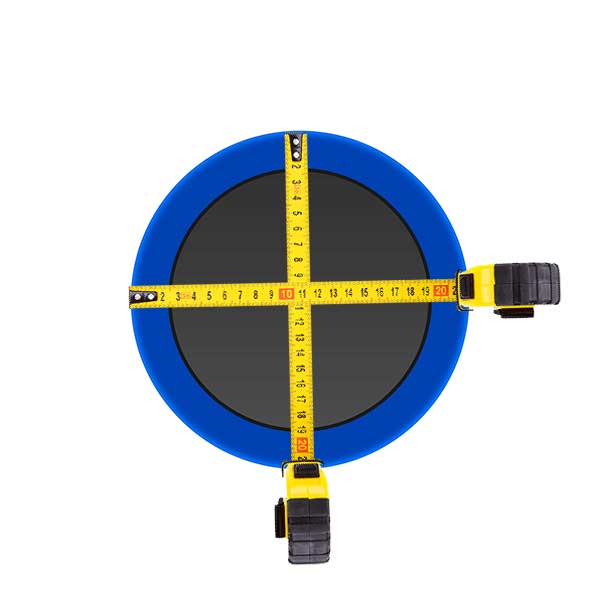
Repeat the process, measuring the diameter of the round trampoline edge-to-edge. That will help you find out if the trampoline is a perfect circle.
How to measure a square or rectangle trampoline:
- Hook your measuring tape’s head on one side of the trampoline’s metal edge.
- Roll the tape back over the trampoline as you move towards the direct opposite point.
- Once on the opposite frame’s edge, lay it flat across the hooked end.
- Take the reading on your end.
- Convert the value you get to feet, as mentioned earlier.
- Repeat the process on the opposite sides
Here’s an illustration of how to measure a rectangular or square trampoline edge-to-edge:
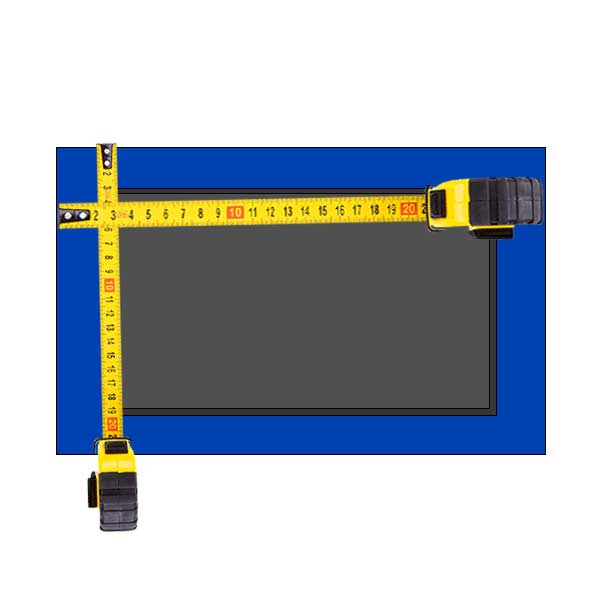
The square shape trampoline will be the easiest to measure. All its sides should give an equal value instead of the different length and width values of the rectangular shape trampoline.
The three are the most popular trampoline shapes in America and the world.
You can still get a unique octagonal shaped trampoline, complete with safety nets. Alternatively, get an oval shape, which is a smooth combination of a round and rectangle shape.
Note: All upper trampoline parts work by the frame size rather than by item size. So, if you have a 12-foot trampoline, you’ll need to get springs and a jumping mat that is ideal for it. Just ask for a 12-foot replacement mat.
What size is a standard trampoline?
The standard trampoline size is 12 feet.
But trampoline sizes range from 8 feet to 16 feet. The 8-foot trampoline size is the most popular in America.
Why is that?
That’s because the 8-foot trampoline is ideal for children between the ages of 4 and 12 years. It can also hold as much weight as 165 pounds (75 kilograms). So, you can buy it now for a small child and use it until they are almost a teenager.
But if you want a backyard trampoline that is suitable for your whole family, the 12-foot option is a full-size trampoline for both kids and adults.
How big is a 12-foot trampoline?
A round frame that measures 12 feet across will be 144 inches in diameter. That is about 366 centimeters across.
An ideal height for it will be around 106 inches from a grass or soil surface.
How much weight can a 12-foot trampoline hold?
Expect a trampoline that measures 12 feet across to bear around 250 to 300 pounds. Every two feet you add to the frame’s size, to say, 14 feet across, will help handle around an additional 50 pounds.
But trampolines are not made equal.
So, check the specific trampoline’s label to see the maximum weight that its manufacturer recommends to keep your loved ones safe.
Still with us?
Awesome. Now here are more answers to your questions.
What trampoline size has 96 springs?
Usually, a 12- to 16-foot trampoline requires up to 96 springs.
If you are looking for a replacement jumping mat, count how many springs your old mat has. Then get a replacement that has as many springs.
Alternatively, count the number of v-rings and matching frame spring holes the trampoline has along its edge. A V-ring is the triangular part that attaches one point of a mat to a hooked end of a spring.
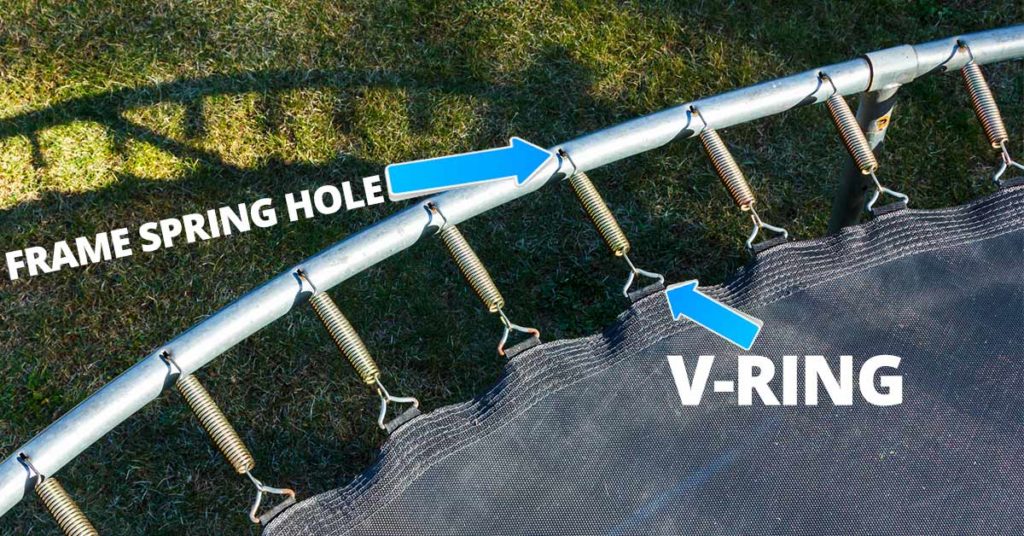
Then get a mat with a similar spring hole or V-ring count.
You can go further and calculate the best spring size for your trampoline.
Calculating trampoline spring sizes and count is crucial to finding the best replacement parts for trampolines.
So, how do you do it the right way?
- Lay a spring on a flat surface. Avoid stretching it.
- Now, use a tape to measure from one hook to the next across its middle section.
- Get the reading in inches.
Springs usually come in 5.5 inches or 7 inches varieties for 8- to 14-foot trampolines.
What’s the best size trampoline to get?
Now, considering everything we’ve covered this far down, you might be wondering: what size of a trampoline should I get?
Well, we’ve got you covered here, too.
Your answers to the following questions will help you decide the best size for your specific needs.
What’s the users’ age?
So, what age is appropriate for a trampoline?
Here’s a handy list:
- 1 to 3-year old toddlers: Mini or toddler trampolines
- 4 to 5-year old children: 4.5- to 6-foot trampoline
- 5 to 6-year old children: 6- to 8-foot trampoline
- 7 to 9-year old children: 8- to 14-foot trampoline
- 10 years and above: 12- to 16-foot trampoline depending on their weight.
- If you want to go all-out, get a gymnastics trampoline. The Olympic trampolines measure 16.5682 feet long by 9.5472 feet wide by 3.7893 feet tall.
Speaking of weight.
How much do the users weigh?
As we’d mentioned earlier, a standard trampoline measures 12 feet across and can bear as much as 300 pounds.
Many trampoline brands can handle up to 50 more pounds for every two feet you add to the diameter.
But just to be sure, check your trampoline’s manufacturer recommendations on the packaging it came with.
If you no longer have the original packaging, search the exact model’s specifications on the manufacturer’s website.
You can also find an exact trampoline for sale on e-commerce sites such as Amazon or Walmart. Make sure to read the specifications carefully, ensuring they are the same as the trampoline you want to order parts for.
Keep in mind that the heavier the users are, the fewer they should bounce on the trampoline mat at the same time.
Oh, there’s something else.
Which is better, a round or rectangle trampoline?
The trampoline’s shape affects several aspects of a bounce, such as how high the bounce will go, the trampoline’s strength, and its wear and tear pattern. Of course, its construction materials will affect those factors as much.
Let’s look at the pros and cons of trampoline shapes.
Advantages of a round trampoline
- Round trampolines make jumpers gravitate towards the center. That’ll help safeguard your children from bouncing off the trampoline.
- Away from the middle, circular shapes offer smaller bounces to keep jumpers from bouncing off.
- Since they are popular, finding replacement parts for their kind will be easy.
- Circular trampolines wear their parts in a uniform pattern, so their bounce quality remains consistent for the longest time compared to other shapes.
Disadvantages of round trampolines:
- Since all parts wear out in unison, you have to pay more to replace more parts than you would for a rectangular trampoline.
- They might not offer the highest bounce among the popular shapes.
Square trampolines offer similar benefits and weaknesses as round options do. But how do rectangular shaped trampolines measure up?
Advantages of rectangular trampolines:
- They offer better balance because they tend to land jumpers on the same spot they bounced on.
- Each rebound will have equal height and power, too.
- Their parts don’t wear out at the same time, so replacing them at different times may help lower your repair or maintenance bill.
- They tend to bear more weight than the round types.
Yet rectangular trampolines are not perfect, either.
Disadvantages of rectangular trampolines:
- They are generally more expensive than round options.
- They require more labor and skill to install
- Since they do not draw jumpers to the center as round ones tend to do, you’ll need to buy extra accessories such as a safety net to safeguard your loved ones.
And there you have it.
Takeaway
It all starts with measuring your trampoline size.
When you do, you’ll also understand how to get the right trampoline mat size for it. Also, it will help you know how to buy the correct springs for your trampoline.
You’ll also learn to tell the difference between a 12- and 14-foot trampoline quickly.
Fortunately, measuring the size of a trampoline is easy when you know what to do. And, hopefully, this guide has helped you understand how to do it right.

